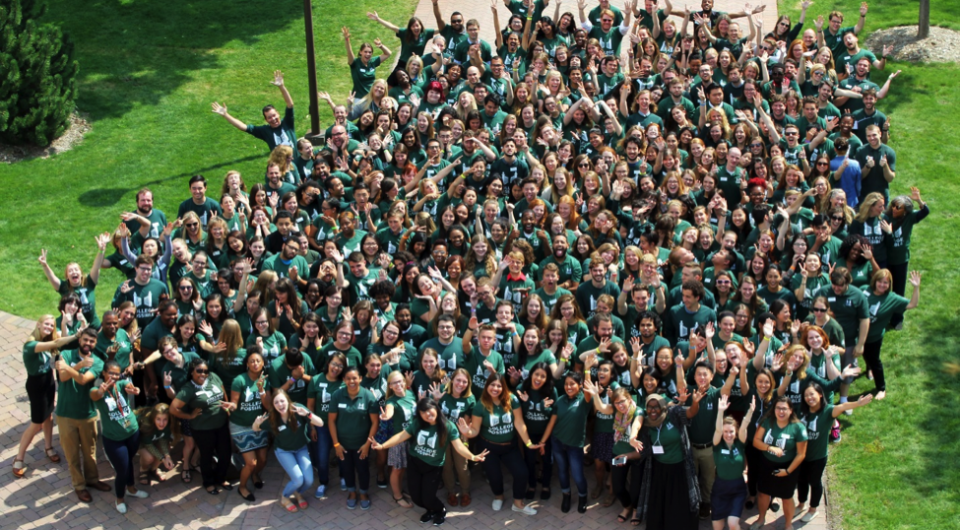
Thanks to the persistence of social entrepreneurs across the country, every day we see strategies that are working and delivering results in a rapidly changing world. This Evidence in Action blog series highlights the voices of the more than 70 social innovation organizations that make up the America Forward Coalition, the results-driven solutions our community has to our country’s most pressing social problems, and the evidence-based federal programs that are critical to scaling the impact of this work. Today we will hear from Traci Kirtley, Chief Program Officer with Coalition organization College Possible about how College Possible harnesses the power of AmeriCorps to coach low-income students to and through college.
Those of us involved in college access and success initiatives know that students from low-income families benefit the most from a college degree, but also face the greatest barriers in attaining that degree. According to the Pell Institute, only 31 percent of low-income students will earn a degree within six years, compared to 59 percent of students in the top income brackets.
For 17 years, College Possible has coached low-income students on their journey to college, and for the past six years, our efforts have also focused on coaching students through college graduation. Our program is run from six sites around the country: Minneapolis-St. Paul, MN; Chicago, IL; Milwaukee, WI; Omaha, NE; Portland, OR; and Philadelphia, PA. With the guidance and support of our near-peer coaches, we have reached almost 30,000 students this year, including 8,000 college students pursuing degrees at 350 campuses across the country. College Possible students are four times more likely to earn their degrees than their low-income peers.
The key to this growing success is our near-peer coaching model – leveraging the power of young, passionate and dedicated recent college graduates serving as AmeriCorps members to offer advice, mentoring and even friendship to a cadre of young people without the resources or background to navigate the often complex world of college preparation and persistence.
Evaluation from Harvard’s Dr. Christopher Avery shows that this intensive, tailored coaching significantly increased college enrollment for low-income students. Compared to their low-income peers, College Possible students are:
- twice as likely to attend a four-year college, and
- four times as likely to earn a bachelor’s degree.
Our model works. It works in a way that allows us to impact the most number of students in the most cost-effective way by harnessing the power of AmeriCorps. This year alone, more than 250 AmeriCorps members and AmeriCorps*VISTAs make up the College Possible service team, and they do this at a fraction of the standard cost to the federal government. In the last fiscal year, for example, organizations supported by AmeriCorps and similar programs raised $1.26 billion in private resources from businesses, foundations, and other sources—exceeding the federal appropriation. In Minnesota, home of College Possible’s national office, investment in AmeriCorps yields a 333 percent return to the public—not to mention the change in the individual student’s life and the life of her family, forever.
And because AmeriCorps is a competitive grant program, our ongoing support from this program requires us to demonstrate evidence of continued success. All AmeriCorps grantees must provide a plan for demonstrating impact with the support of federal funds, and evidence of success to continue to receive funding. At College Possible, the use of data to drive program improvements and measure progress toward our goals is woven directly into the daily work of our team. We’re able to achieve best-in-class results for our students by focusing like a laser on their success and measuring that impact. We are a strong AmeriCorps program precisely because AmeriCorps shares this evidence-driven approach.
The importance of AmeriCorps cannot be understated. Administered by the Corporation for National & Community Service (CNCS), AmeriCorps engages thousands of Americans in addressing our nation’s challenges through service. As CNCS states, it harnesses “America’s most powerful resource – the energy and talents of our citizens – to solve problems.” While AmeriCorps members benefit College Possible and the students we serve, their impact is multifaceted. In the past 23 years, AmeriCorps members have served for 1.4 billion hours across America, mobilizing more than 2.3 million volunteers addressing seemingly intractable issues.
Key among these issues is the degree divide in the United States. With a nation facing a shortage of college-educated workers to fill the roles of retiring Baby Boomers, closing this divide is the surest way to ensure the long-term prosperity and relevance of this country. In addition to filling jobs, the next generation of college graduates will cost the federal government less in social services and pay more in taxes. In addition, this next-generation comprises our future leaders, leaders who will need to be well-educated, from diverse backgrounds, and prepared to face the challenges of a global, technology-driven economy. Eliminating funding of AmeriCorps removes not only a cost-effective means of educating these leaders but also leaders for generations to come.
About College Possible
College Possible is a growing nonprofit coaching low-income students to and through college to break the cycle of poverty and empower the next generation of leaders.
Leave a Reply
You must be logged in to post a comment.